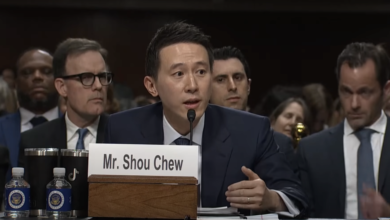Though it represents neither profound artistry nor fully developed political analysis, Paul Haggis’ (“Crash”) new film “In the Valley of Elah” is a work of deeply felt humanism and represents a step forward in his work.
The film tells the story of Hank Deerfield (played by Tommy Lee Jones), a Vietnam vet and retired military investigator,
 |
When he learns of his son’s disappearance, Hank immediately drives from his home in Tennessee to Fort Rudd, in New Mexico, the base from which his son had disappeared. A few days later, Mike’s body is discovered in an empty field near the base, brutally dismembered and charred almost beyond recognition.
Haggis wrote and directed the film. His source material was an actual murder, the death of Richard Davis in 2003. The murder was first written about in a Playboy article published in May of 2004, and Haggis worked closely with the author of that piece, Mark Boal, to create the screenplay for “Elah.”
Haggis altered key details and amplified the story—changing the military base and names of the characters, adding material created from interviews with returning Iraq war veterans and expanding the role of the father in the subsequent investigation.
Indeed, the story principally takes the form of a murder mystery. Hank encounters profound obstacles—from the local police and especially the military hierarchy—in his search for his son’s killers. His principal ally in the search is a local detective and single mother, Emily Sanders (played by Charlize Theron).
In contrast to the histrionic tone of “Crash,” Haggis’s previous film, “In the Valley of Elah” is a work of relative quiet and discipline.
The performances are generally strong and understated, with special mention to Tommy Lee Jones who gives one of the strongest and most modest performances of his career.
Likewise, the camera work by Roger Deakins is direct, quiet and mostly subtle, bolstered by an effective use of the over-employed bleach-bypass process—which mutes colors and heightens contrast—producing a gloomy effect entirely suited to the work itself.
Images of the war itself are presented in a technologically plausible, chillingly cryptic manner. When Hank first arrives on the base, he covertly removes his son’s cell phone from his bunkroom.
The phone was damaged beyond use by the dessert heat in Iraq. Hank finds a local computer technician who is able to extract fragments of low-resolution videos taken by Mike throughout his deployment. The low-resolution fragments are pixilated, incomplete and utterly harrowing. They depict the intensifying chaos of the war itself, spiraling violence and cruelty and, finally, outright torture and murder carried about by the American soldiers, including by Mike himself.
Criticisms of the war, its causes and motivations are limited and unsatisfying. Fragments of speeches by Bush and his cronies are spread throughout the film, overheard on radio and television news. But the complicity of the Democrats in launching and continuing the war is never so much as alluded to.
The film’s point of view is that this war is Bush’s war, plain and simple. The movie acknowledges the war as a human catastrophe, but never quite transcends a rather simplistic “war is hell” formulation.
From a formal point of view, the film breaks no new ground. Haggis’s penchant for overstated cinematic metaphor and a clumsy use of pop music are the most awkward missteps, but the film is nonetheless mostly quietly accomplished and affecting.
Its greatest strength lies in its complex portrait of returning Iraq war veterans. The soldiers are unequivocally shown to be exploited workers in uniform—white, Black and Latino—sent to fight a vicious war against their own impulses and interests.
The consequence is deeply traumatizing for Iraq, Iraqis and also for U.S. soldiers, who return from the war physically devastated and emotionally mutilated. The film does an extraordinary job of rendering these consequences in complex and compassionate terms.
Despite its political and aesthetic limitations, “In the Valley of Elah” is a film to be respected and acknowledged.
Its key messages—that the war in Iraq is a human catastrophe and that returning soldiers are key to its eventual resolution—dovetail powerfully with the ANSWER Coalition (Act Now to Stop War and End Racism)-led mobilization against the war that took place in Washington, D.C. on Sept. 15. That anti-war action—the first headed by Iraq war veterans themselves—marked a turning point and sharp intensification of the movement against the war.
Perhaps likewise, “In the Valley of Elah” will mark a meaningful turning point in the films of Paul Haggis.






